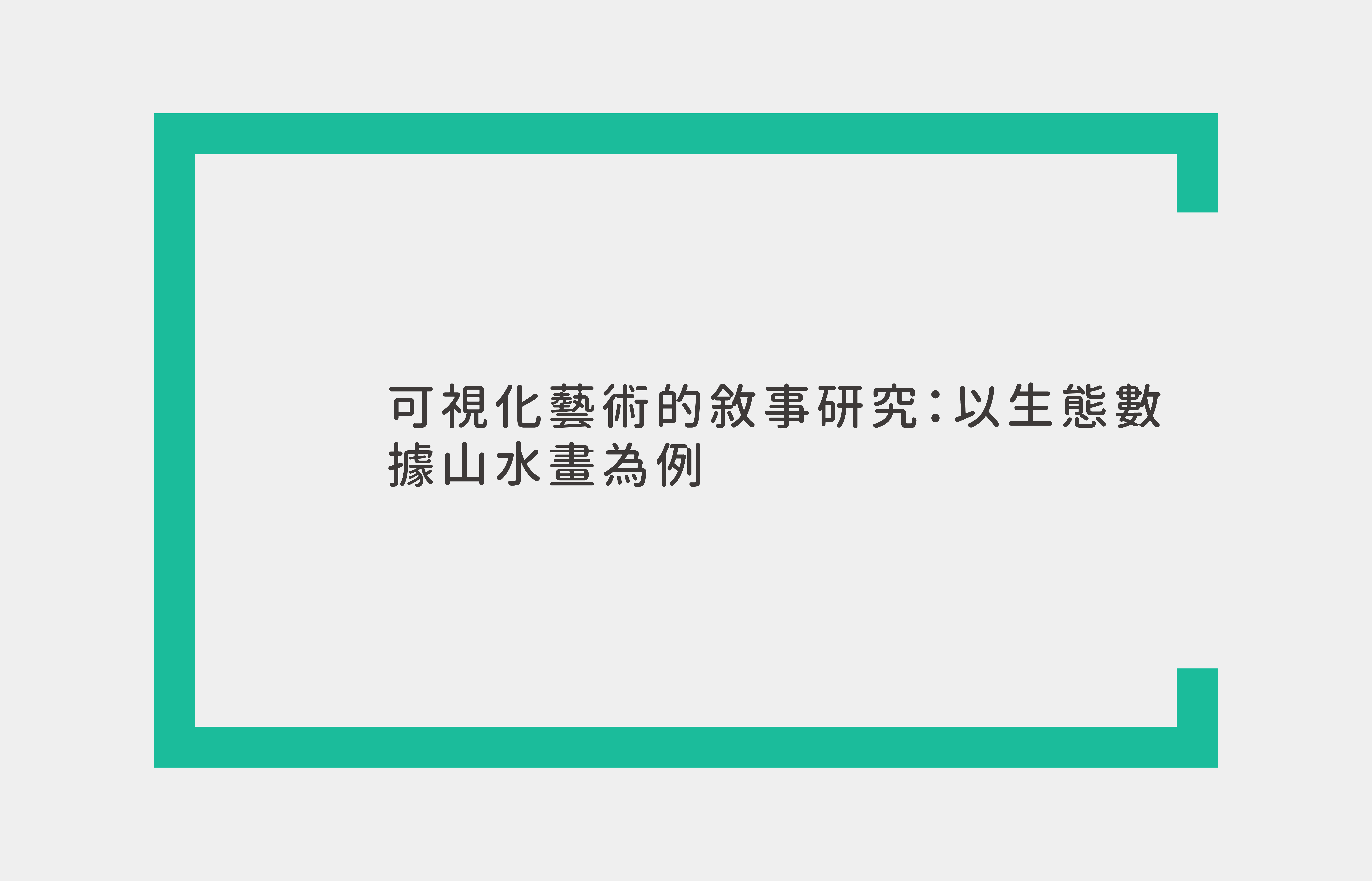可視化藝術的敘事研究:以生態數據山水畫為例

中文摘要
數據可視化敘事是近幾年來出現的一種相對較新的資訊表達方式。相關技術在數據可視化中的應用越來越普遍,用戶也越來越容易接受。藝術家可以運用各種多媒體、符號和隱喻,獨立創造出一種表達“大數據”並與現實生活溝通的視覺形式。可視化是強大而又必要的溝通媒介,如果把“可視化敘事”視為一種交流過程,那麼藝術家的表演是如何構思、開發、傳遞和接受的,如何吸引觀眾,準確理解“大數據”,受可視化的影響,自然值得探討。
因此,本研究旨在提出一個架構,關注藝術家的觀念如何影響創作過程,以及創作過程如何被觀眾所理解。通過一個將“大數據”轉化為“可視化藝術”的案例研究,從四個步驟對藝術家的創作活動進行了分析。結果表明,該方法可以應用於理解數據可視化,並為藝術家提供一種創作思路,能夠更易於觀眾溝通。此外,研究框架為探索“大數據”如何轉化為藝術形式提供了可執行的途徑,值得進一步深入研究。
Abstract
Visual data storytelling is a relatively new terminology that has emerged over the last decade. The use of information technology in data visualizing is becoming more common and accessible to users. Artists apply a variety of multimedia, symbols and metaphors to independently create a visual form that expresses “big data” and communicates with real life. The visual data are the media that provide powerful and essential means of communication. If “visual data storytelling” is viewed as a process of communication, it follows naturally that how the artist’s performances are conceived, developed, delivered and received, and how the audience is attracted, accurately understanding the “big data,” and affected by the data visualization are worth exploring. Therefore,
this study is intended to propose a framework focusing on how the conception of the artist affects the creation process and how the creation process is understood by the audience. The artist’s creation activities were analyzed through the framework of four steps using a case study intended
to turn “big data” into “visual data storytelling.” The results showed that the approach could be applied to understanding data visualization and provides artists with an idea of how to concentrate their efforts at the creation stage, the easier to communicate with their audience. In addition, the research framework seems to provide a better way to explore the understanding of how “big data” transforms into art forms, which is clearly worthy of further study.
參考文獻
1. Nathan, Y.: Visualize this: the FlowingData guide to design, visualization, and statistics. John Wiley & Sons. Indianapolis, IN (2011).
2. Gershon, N., & Page, W.What storytelling can do for information visualization. Communications of the ACM 44(8), 31-37 (2001).
3. Cairo, A.: The Functional Art: An introduction to information graphics and visualization. New Riders Press. Berkeley, CA (2012).
4. 4. Kosara, R.: Visualization criticism-the missing link between information visualization and art. In: 11th International Conference Information Visualization. pp. 631-636. IEEE, Zurich (2007).
5. Saket, B., Endert, A., & Stasko, J.: Beyond usability and performance: A review of user experience-focused evaluations in visualization. In: Proceedings of the Sixth Workshop on Beyond Time and Errors on Novel Evaluation Methods for Visualization. pp. 133-142 (2016).
6. Norman, D. A.: Emotional design: Why we love (or hate) everyday things. Basic Books. New York (2004).
7. Wurman, R. S.: Information Anxiety 2. Que. Indianapolis, IN (2000).
8. Kosara, R., & Mackinlay, J.Storytelling: The next step for visualization. Computer 46(5), 44-50 (2013).
9. Edward, S., & Heer, J.Narrative visualization: Telling stories with data. IEEE transactions on visualization and computer graphics 16(6), 1139-1148 (2010).
10. Chen, M., Ebert, D., Hagen, H., Laramee, R., Liere, R. v., Ma, K.-L., . . . Silver, D.Data, information, and knowledge in visualization. IEEE Computer Graphics and Applications 29(1), 12-19 (2008).
11. Ackoff, R. L.From data to wisdom. Journal of applied systems analysis 16(1), 3-9 (1989).
12. Zeleny, M.: Human systems management: Integrating knowledge, management and systems. World Scientific (2005).
13. Jakobson, R.: Language in literature. The Belknap Press of Harvard University Press. Cambridge, MA (1987).
14. Lin, R.Transforming Taiwan aboriginal cultural features into modern product design: A case study of a cross-cultural product design model. International Journal of Design 1(2), 45-53 (2007).
15. Lin R., Lin PH., Shiao WS., Lin SH. Cultural Aspect of Interaction Design beyond Human-Computer Interaction. In: Aykin N. (eds.) IDGD 2009. LNCS, vol 5623. Springer, Berlin, Heidelberg (2009).
16. Lin, C.-L., Chen, J.-L., Chen, S.-J., & Lin, R.The cognition of turning poetry into painting. Journal of US-China Education Review 5(8), 471-487 (2015).
17. Fiske, J.: Introduction to communication studies. Routledge. London (1990).
18. Barthes, R.: Elements of semiology. Hill & Wang. New York (1968).
19. Silverman, K.: The subject of semiotics. Oxford University Press. New York (1983).
20. Gao Y., Wu J., Lee S., Lin R. Communication Between Artist and Audience: A Case Study of Creation Journey. In: Rau PL. (eds.) HCII 2019. LNCS, vol 11577. Springer, Cham (2019).
